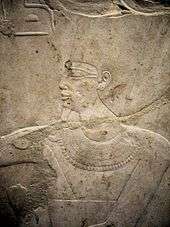Mentuhotep III
| Mentuhotep III | |||||||||||||||||||||||||||||||||||||||||||||||||||||||||||||||||||||||||||||||||
|---|---|---|---|---|---|---|---|---|---|---|---|---|---|---|---|---|---|---|---|---|---|---|---|---|---|---|---|---|---|---|---|---|---|---|---|---|---|---|---|---|---|---|---|---|---|---|---|---|---|---|---|---|---|---|---|---|---|---|---|---|---|---|---|---|---|---|---|---|---|---|---|---|---|---|---|---|---|---|---|---|---|
 Osiride statue of the 11th dynasty pharaoh Mentuhotep III, on display at the Museum of Fine Arts, Boston. | |||||||||||||||||||||||||||||||||||||||||||||||||||||||||||||||||||||||||||||||||
| Pharaoh | |||||||||||||||||||||||||||||||||||||||||||||||||||||||||||||||||||||||||||||||||
| Reign | 2010 BC – 1998 BC (11th dynasty) | ||||||||||||||||||||||||||||||||||||||||||||||||||||||||||||||||||||||||||||||||
| Predecessor | Mentuhotep II | ||||||||||||||||||||||||||||||||||||||||||||||||||||||||||||||||||||||||||||||||
| Successor | Mentuhotep IV | ||||||||||||||||||||||||||||||||||||||||||||||||||||||||||||||||||||||||||||||||
| |||||||||||||||||||||||||||||||||||||||||||||||||||||||||||||||||||||||||||||||||
| Mother | Tem | ||||||||||||||||||||||||||||||||||||||||||||||||||||||||||||||||||||||||||||||||
| Died | 1998 BC | ||||||||||||||||||||||||||||||||||||||||||||||||||||||||||||||||||||||||||||||||
Sankhkare Mentuhotep III (also Montuhotep III)[4] of the Eleventh dynasty was Pharaoh of Egypt during the Middle Kingdom. He was assigned a reign of 12 years in the Turin Canon.
Reign
Mentuhotep III succeeded his father Mentuhotep II [5] to the throne. It is believed that, following his father's long 51 years of reign, Mentuhotep III was relatively old when he acceded to the throne and reigned for 12 years. Despite its short duration, Mentuhotep's reign is known for his expedition to Punt and architectural innovations.
Name
Mentuhotep III's titulary is very similar to the third and final one of his father. Mentuhotep III is known to have had at least two praenomen: the well known Sankhkare and also
|
snfr-k3-ra
"He who embellishes the Soul of Re"
Expedition to Punt
Mentuhotep III sent an expedition to the Land of Punt during the 8th year of his reign, something that had not been done since the Old Kingdom. An inscription in the Wadi Hammamat describes the expedition as being 3000 men strong and under the command of the steward Henenu. As they left Coptos in direction of the Red Sea, they dug 12 wells for future expeditions and cleared the region of rebels. They returned from Punt with incense, gum and perfumes, and quarried the Wadi Hammamat for stones.
Monuments

Sankhkare Mentuhotep was responsible for several building projects in the 12 years of his reign. His own mortuary temple was begun in Deir el-Bahari, but never completed. The temple was located a short distance from his father's mortuary temple. A causeway would have led up to a temple platform. Inscriptions show that the king was buried in a chamber cut into the rock-face.[6]
Sankhkare Mentuhotep also had a mud-brick temple erected at Thoth Hill in Western Thebes. The temple was built on the site of an older archaic temple. It was dedicated to the god Montu-Ra. This temple may have been destroyed by an earthquake towards the end of the 11th dynasty.[6]
Family
Mentuhotep III was the son and successor of Mentuhotep II. One of the wives of Mentuhotep II, Tem, was given the title Mother of the Dual King and based on that title she is almost certainly the mother of Mentuhotep III. Mentuhotep III's family is mostly a mystery. It is currently believed that he fathered his successor Mentuhotep IV with one of his harem wives, Imi. This is however still debated [7] Mentuhotep IV's mother is known to have been Queen Imi. If he was the son of Mentuhotep III, Imi must have been the wife of Mentuhotep III.[8]
References
- ↑ King List (chronological)
- ↑ Clayton, Peter A. Chronicle of the Pharaohs: The Reign-by-Reign Record of the Rulers and Dynasties of Ancient Egypt. Thames & Hudson. p72. 2006. ISBN 0-500-28628-0
- 1 2 Karl Richard Lepsius: Denkmaller, Abtheilung II Band IV Available online see p. 152
- ↑ Firth, Lesley (editor-in-chief); et al. (1985). "Mentohotep III". Who Were They? The Simon & Schuster Color Illustrated Question & Answer Book. Little Simon Book, Simon & Schuster, Inc., New York City. p. 12. ISBN 0671604767.
- ↑ "Mentuhotep III". ib205.tripod.com. 9 December 2012. Retrieved 28 October 2016.
- 1 2 Wilkinson, Richard H., The Complete Temples of Ancient Egypt, Thames and Hudson, 2000,pp. 37, 172, 173, 181, ISBN 0-500-05100-3
- ↑ Dodson, Aidan and Hilton, Dyan. The Complete Royal Families of Ancient Egypt. Thames & Hudson. 2004. ISBN 0-500-05128-3
- ↑ Tyldesley, Joyce. Chronicle of the Queens of Egypt. Thames & Hudson. 2006, pp. 66-68. ISBN 0-500-05145-3
Further reading
- Grajetzki, W. (2006). The Middle Kingdom of Ancient Egypt: History, Archaeology and Society. London: Duckworth. pp. 23–25. ISBN 0-7156-3435-6.
| Wikimedia Commons has media related to Mentuhotep III. |
| Preceded by Mentuhotep II |
Pharaoh of Egypt Eleventh Dynasty |
Succeeded by Mentuhotep IV |
